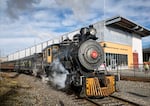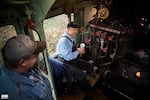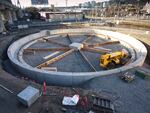
In this supplied photo, the Polson No. 2 steam engine heads southeast from Oregon Rail Heritage Center in Southeast Portland. Volunteers at the center will fire up the Polson No. 2 for National Train Day on May 13, 2023.
kLik / Oregon Rail Heritage Center
On Saturday, May 13, visitors to the Oregon Rail Heritage Center in Southeast Portland can take a ride on an 111-year-old steam locomotive. Nowadays, most trains are electric or diesel-powered, but steam engines used to be the norm.
“Every day in America up until the mid-50s, you’d hear a steam whistle all the time,” said Pat Tracy, operations manager for the Oregon Rail Heritage Center. “Steam engine was just part of what happened every day, and then they left.”
Tracy works as part of a team of more than 100 volunteers bringing back the forgotten steam locomotive magic for National Train Day. The event, started by Amtrak in 2008, commemorates the completion of the first transcontinental railroad in the U.S.
To celebrate National Train Day this year, Tracy and other volunteers will fire up the Edwardian-era Polson No. 2 steam locomotive, built in 1912. It will slowly chug down the Springwater Corridor on a 45-minute round-trip journey with views of the Willamette River, providing a historic contrast to modern diesel trains.
Tracy said the train was originally built for Polson Logging to haul big loads of lumber. “It’s what we would call a rod engine, traditional, versus a geared engine, like some logging locomotives — cute little engine,” he said.
It takes someone who works on massive machines to think that the giant metal behemoth like the Polson No. 2 is a “cute little engine.”
That’s probably because of Tracy’s experience working on the Southern Pacific 4449, an even bigger steam locomotive that weighs almost a million pounds. The 4449 is lovingly called the “Big Boy” by volunteers.
In 1974, the Big Boy was taken out of retirement at Oaks Park and restored to pull the Bicentennial Freedom Train across the U.S. It’s a geared steam engine meant for climbing mountains, with a top speed of 100 miles per hour. The driving wheels are more than 6 1/2 feet in diameter.

In this supplied photo from December 2017, an unidentified volunteer looks on as Oregon Rail Heritage Center volunteer Pat Tracy sits in the cab of the Southern Pacific 4449 steam locomotive.
KLiK / Oregon Rail Heritage Center
The cab of the 4449 — the train version of a cockpit — is a steampunk wonderland. Dozens of red metal knobs, like the kind you would use to turn on a regular garden hose, are in every direction of the driver’s seat. There isn’t even a proper windshield; the engineers would stick their heads out the windows to see ahead.
On days like National Train Day, a fire fueled by recycled motor oil will roar inside the firebox by the engineer.
“The steam locomotive is nothing more than a big furnace, but it’s also a pressure vessel. It’s just like a pressure kettle on a stove,” said Tracy. “It builds up pressure in there, [and] you use that steam to move the piston that pushes against the side rods that make the wheels turn.”
Tracy has worked on the 4449 for over 30 years and has a long history with steam engines. His father, uncle and grandfather were all railroaders. Although his professional background is with planes in the Air Force, Tracy believes that trains capture the imagination of young children, and he sees it at the rail center all the time.
“Families take train rides, run around the center to look at the big engines and make the day a family event,” he said. “People are coming into this place to look at these steam locomotives. ... That’s really the crown jewel of the facility.”
The steam locomotives require a meticulous examination of every rivet and bolt every 15 years to stay licensed to ride the rails. With such care, volunteers could keep these locomotives going for another century. When asked if the National Train Day rides are just a recruitment tool for the next generation of volunteers, Tracy smiled: “We hope to influence some kids that, hey, you want to end up working on a big steam engine? You can do that here.”
Carolyn Meeker, who works with those dedicated volunteers as the person in charge of membership and event planning, said the best part of these rail excursions is getting to see the reactions to trains, especially from first-time riders. She recalled her excitement the first time she rode along during a steam excursion, setting up the bar before the event started: “I’m the only one on board and they’re just moving it into position. I nearly peed my pants. I was so excited. I knew I loved trains.”
Visitors on National Train Day will also be able to see the center’s newest project: a historic 112-foot turntable. It’s the last historic element of Portland’s former Brooklyn Roundhouse. It was used to turn the heavy steam locomotives in the direction the train needed to travel. Turntables became less common once diesel engines came along, though some have come back into use because of modern-day “positive train control” computerized systems. The turntable is powered by electric motors, but many were pushed by people back in the steam era.

In this supplied photo, the pit for the historic locomotive turntable at Oregon Rail Heritage Center is installed.
KLiK / Oregon Rail Heritage Center
The goal is to open the turntable exhibit for visitors this summer. Just a few weeks ago, the 89 year old turntable made its first circle around in its new home.
Volunteer Dale Birkholz is working on the turntable project after having operated it at the Brooklyn Yard, but he’ll be helping out on the tracks for National Train Day.
“We don’t have an opportunity here to fire up the steam engines that frequently,” he said. “So that’s a reward for working down here. But the real reward is ... keeping these things alive.”
Tickets for the National Train Day steam excursion are available through Oregon Rail Heritage Foundation’s website.
